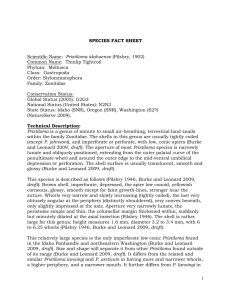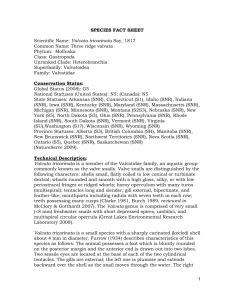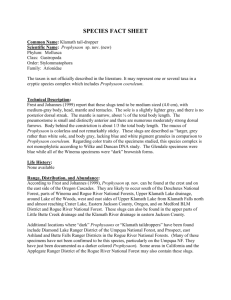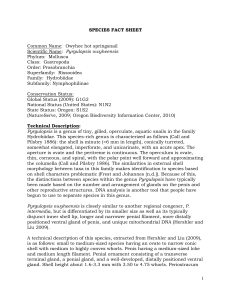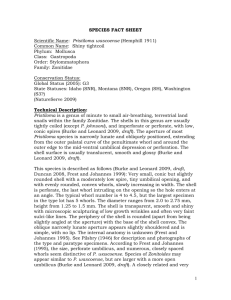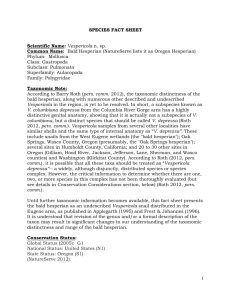Vespericola n. sp., Oak Springs Hesperian
advertisement
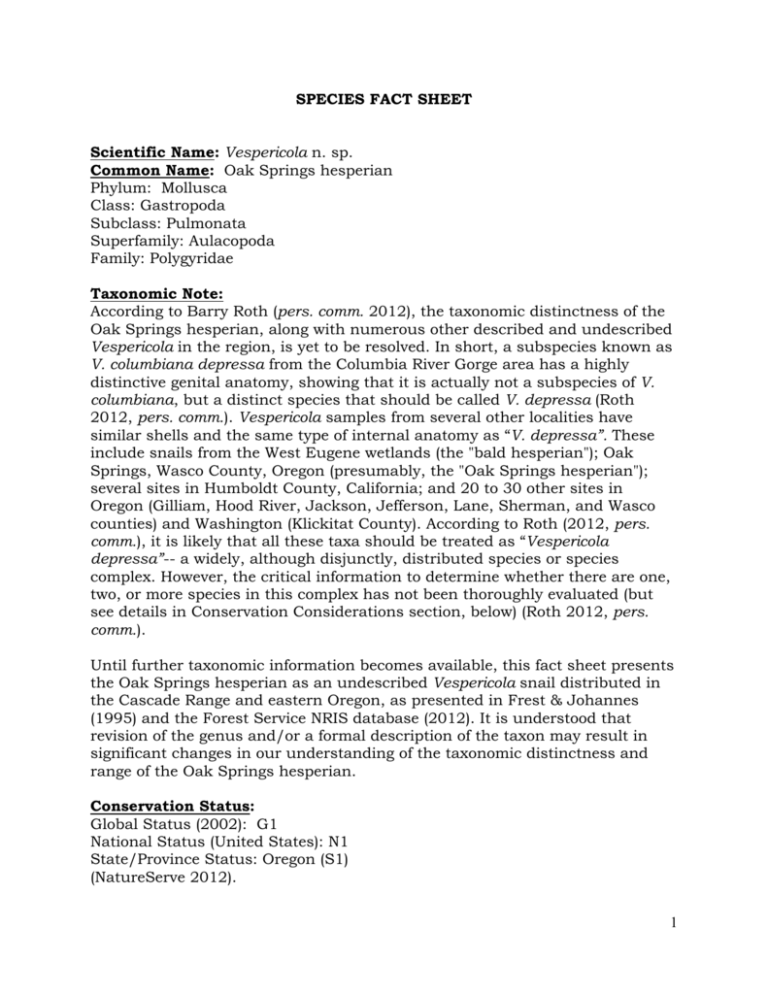
SPECIES FACT SHEET Scientific Name: Vespericola n. sp. Common Name: Oak Springs hesperian Phylum: Mollusca Class: Gastropoda Subclass: Pulmonata Superfamily: Aulacopoda Family: Polygyridae Taxonomic Note: According to Barry Roth (pers. comm. 2012), the taxonomic distinctness of the Oak Springs hesperian, along with numerous other described and undescribed Vespericola in the region, is yet to be resolved. In short, a subspecies known as V. columbiana depressa from the Columbia River Gorge area has a highly distinctive genital anatomy, showing that it is actually not a subspecies of V. columbiana, but a distinct species that should be called V. depressa (Roth 2012, pers. comm.). Vespericola samples from several other localities have similar shells and the same type of internal anatomy as “V. depressa”. These include snails from the West Eugene wetlands (the "bald hesperian"); Oak Springs, Wasco County, Oregon (presumably, the "Oak Springs hesperian"); several sites in Humboldt County, California; and 20 to 30 other sites in Oregon (Gilliam, Hood River, Jackson, Jefferson, Lane, Sherman, and Wasco counties) and Washington (Klickitat County). According to Roth (2012, pers. comm.), it is likely that all these taxa should be treated as “Vespericola depressa”-- a widely, although disjunctly, distributed species or species complex. However, the critical information to determine whether there are one, two, or more species in this complex has not been thoroughly evaluated (but see details in Conservation Considerations section, below) (Roth 2012, pers. comm.). Until further taxonomic information becomes available, this fact sheet presents the Oak Springs hesperian as an undescribed Vespericola snail distributed in the Cascade Range and eastern Oregon, as presented in Frest & Johannes (1995) and the Forest Service NRIS database (2012). It is understood that revision of the genus and/or a formal description of the taxon may result in significant changes in our understanding of the taxonomic distinctness and range of the Oak Springs hesperian. Conservation Status: Global Status (2002): G1 National Status (United States): N1 State/Province Status: Oregon (S1) (NatureServe 2012). 1 Technical Description: The Oak Springs hesperian is a pulmonate (air-breathing) land snail in the family Polygyridae. This family is comprised of small to large sized snails with well reflected lip margins and often with apertural teeth (Burke & Leonard 2009, draft). The shells of many species in this family are adorned with periostracal hairs, although the hairs are lost by adulthood in most species (Burke & Leonard 2009, draft). Five genera occur in the Pacific Northwest: Allogona, Cryptomastix, Hochbergellus, Trilobopsis, and Vespericola. Of these, the genus Vespericola is characterized by having shells of a distinctive and fairly uniform shape: the body whorl is rather capacious, the spire is moderately elevated and generally conic, and there is usually a distinct constriction just before the reflected lip margin. The northern species are usually without dentition, but some species from southwestern Washington and farther south have a parietal tooth or lamella. The shell is thin and fragile; the umbilicus is perforate to very narrowly umbilicate. Most are adorned with periostracal hairs (seldom lacking) of varying size and density. A similar genus, Hochbergellus, is indistinguishable from Vespericola by external characteristics (Burke & Leonard 2009, draft). Within the Vespericola genus, general shell characteristics are so similar that species-level identification from shells alone can be difficult or impossible, and dissection is necessary for positive identification of the species (Burke & Leonard 2009, draft). The Oak Springs hesperian is described by Frest & Johannes (1995) as reddish-brown in color, with a thin, reddish-brown apertural lip lacking-dentition, and no parietal tooth. The shell is low-spired, with a distinctly convex, well-rounded base and minute umbilicus. The periostracum is completely and finely hirsute, somewhat as in Vespericola pilosa (See Photograph in Appendix 4). Internally, this species does not closely resemble typical forms such as V. pilosa, but bears some resemblance to snails that are currently recognized as Vespericola columbiana depressa, the latter of which has genitalia composed of a thick, fusiform penial sheath that completely encloses a slender penis (Roth 2012, pers. comm.). The Oak Springs hesperian differs from V. c. depressa largely in shell characters: the convex base, reddish color, very small umbilicus, and dense pelage (setae) on the shell (Frest & Johannes 1995). As discussed in the Taxonomic Note, above, the taxonomic relationship between the Oak Springs hesperian, what is currently recognized as V. columbiana depressa, and other Vespericola is currently unresolved and in need of further study (Roth 2012, pers. comm.). Life History: Little is known regarding the feeding habits, growth, reproduction, or life span of the Oak Springs hesperian. Vespericola snails, in general, feed by scraping 2 algae, yeast, bacteria and diatoms from rock and woody surfaces, and may also consume green plant materials (Duncan 2009). Like other pulmonate snails, members of this genus are hermaphroditic, having a single male and female gonad organ and exchanging gametes with conspecific individuals when conditions are favorable (Duncan 2005). Eggs and sperm of pulmonate snails often develop at different times within the individual such that self-fertilization is uncommon (Nordsieck 2010). Once fertilized, the egg develops into a veliger larval stage, found inside of the egg. When the veliger matures, a fully formed juvenille snail emerges from the egg (Nordsieck 2010). The life span and reproduction of this taxon are probably similar to that of the closely related V. columbiana depressa, a species which lives approximately 3 to 5 years, reproduces only once in its lifetime (semelparous), and likely breeds during the second season, presumably laying eggs in very moist locations such as in wet moss or under rocks or wood (Duncan 2009). Vespericola c. depressa is entirely terrestrial, but seeks refugia sites where the humidity level is relatively high and temperature is constant, such as deep within cracks in mud, in rock talus or under permanently moist vegetation (Duncan 2009). This species may travel several hundred feet during a season, only to return to original refugia sites. It may be present all year, but is probably not active under snow in winter (Duncan 2009). Range, Distribution, and Abundance: The Vespericola genus is endemic to western North America, occupying the Pacific states and provinces from southern Alaska to west-central California, and occurring to the east as far as northern Idaho and into Montana (Burke & Leonard 2009 draft). The Oak Springs hesperian is known only from Wasco County in eastern Oregon. According to Frest & Johannes (1995), this taxon was originally distributed in the central portion of the Lower Deschutes River corridor, mostly in the vicinity of Maupin. A number of sites for this taxon in the NRIS, GeoBob, and ORBIC databases (2013) have been recently determined to be incorrect, including sites in Hood River, Clackamas, Josephine, Douglas, and Klamath Counties. Since this taxon is not completely described, and since the genus is in need of taxonomic revision, the known range of this taxon is subject to change (Roth 2012, pers. comm.). Forest Service/BLM Lands: This species is suspected on BLM land in the Prineville District, based on very close proximity to a reliable/presumably 3 extant site (Deixis MolluscDB Database 2012, Johannes 2013 pers. comm.). There are also a number of “extinct colonies” in this region (“Maupin area”) that may be on or near Prineville District BLM land (Frest & Johannes 1995). Abundance: Abundance estimates of this species have not been conducted. Habitat Associations: In Wasco County, Eastern Oregon, Frest & Johannes (1995) report that this taxon occurs on basalt substrate, and persistence of moisture is critical. In drier areas, association with springs or seeps (often with Mimulus, Rorippa, and Cicuta cover) in basalt taluses or short cliffs is invariant (Frest & Johannes 1995). For example, one colony occurs in rather dry sage scrub, but the areas occupied by this species have perennial seeps, and association with very moist areas is typical (Frest & Johannes 1995). As such, the species is characterized as a notophile (dependent on high levels of moisture) (Frest & Johannes 1995). Frest & Johannes (1995) list several common plant associates in eastern Oregon, including Cornus stolonifera, Salix spp., Physocarpus, Rhus, Rubrus, Rosa, and Clematis. Snails with which this species is known to co-occur include Monadenia fidelis minor and an Ancotrema species (Frest & Johannes 1995). Threats: When a species is known from only a few locations, any modification of the environment could be a potential threat to its survival. According to Frest & Johannes (1995), much of the original range of the Oak Springs hesperian in eastern Oregon has been impacted by road and railroad track (Burlington Northern placement) and by development in the Deschutes River valley. Talus sites in this area have been impacted by hatchery and road construction and by diversion for fish hatchery and human and stock water supply. Additionally, much of the Lower Deschutes River corridor area is grazed by livestock, which has essentially extirpated some colonies. Recent intense fires have also impacted sites severely. Recreational usage of this area has increased dramatically in the last few years, and plans for more roads, campgrounds, and other recreation enhancements may impact this species negatively unless done carefully. Downward trends in population and number of sites are already evident, and several extinct colonies have been noted in the Maupin area of Oregon (Frest & Johannes 1995). Conservation Considerations: Research: The most critical next step for this undescribed taxon is to evaluate its taxonomic distinctness and, if distinct, publish a formal description of the species. According to Barry Roth (pers. comm. 2012), the taxonomic distinctness of the Oak Springs hesperian, along with numerous other 4 described and undescribed Vespericola in the region, is yet to be resolved. In short, a subspecies known as V. columbiana depressa from the Columbia River Gorge area has a highly distinctive genital anatomy (a thick, fusiform penial sheath that completely encloses a slender penis), showing that it is actually not a subspecies of V. columbiana, but a distinct species that should be called V. depressa (Roth 2012, pers. comm.). Vespericola samples from several other localities have similar shells and the same type of internal anatomy as “V. depressa.” These include snails from Oak Springs, Wasco County, Oregon (presumably, the "Oak Springs hesperian"); the West Eugene wetlands (the "bald hesperian"); several sites in Humboldt County, California; and 20-30 other sites in Oregon (Gilliam, Hood River, Jackson, Jefferson, Lane, Sherman, and Wasco counties) and Washington (Klickitat County). According to Roth (2012, pers. comm.), it is likely that all these taxa should be treated as “Vespericola depressa”-- a widely, although disjunctly, distributed species or species complex. However, the critical information to determine whether there are one, two, or more species in this complex has not been thoroughly evaluated (Roth 2012, pers. comm.). Barry Roth initiated the process of resolving the taxonomy of this genus a few years ago (using close morphological comparisons), but has not been able to complete the project due to lack of resources. According to Roth (2012, pers. comm.), this work will help clarify whether the " Oak Springs hesperian" is a species separate from V. depressa or simply a remote occurrence of it. Frest & Johannes (1995) make a case for the former, although their evidence needs to be considered in light of other Vespericola occurrences in many counties that have the general "look" of depressa shells, and, sometimes, the thick, fusiform sheath as well (Roth 2012, pers. comm.). Inventory: Surveys are not recommended for this taxon until its taxonomic distinctness has been determined, since results of the taxonomic work are likely to alter our understanding of the species’ range and conservation needs. Prepared by: Sarah Foltz Jordan, Xerces Society Date: November 2012; updates 19 March 2013 Edited by: Sarina Jepsen, Xerces Society Date: 6 December 2012 Final Edits: Rob Huff, BLM/FS Portland, Oregon Date: 20 March 2013 ATTACHMENTS: (1) References (2) List of pertinent or knowledgeable contacts 5 (3) (4) (5) Map of species distribution Photograph of similar species Terrestrial Gastropod Survey Protocol, including specifics for this species ATTACHMENT 1: References: Burke, T. and W. Leonard. 2009. Land Mollusks of the Pacific Northwest United States. In preparation. Deixis MolluscDB database. 2012. An unpublished collection of mollusk records maintained by Ed Johannes. Duncan, N. 2005. Conservation Assessment for Vertigo n. sp., Hoko Vertigo. Originally issued as Management Recommendations by John S. Applegarth, February 1999. Revised by Nancy Duncan, October 2005. USDA Forest Service Region 6 and USDI Bureau of Land Management, Oregon and Washington, 16 pp. Duncan, N. 2009. Species Fact Sheet for Vespericola columbiana depressa, Dalles Hesperian. Prepared for ISSSSP. Available at: http://www.fs.fed.us/r6/sfpnw/issssp/species-index/faunainvertebrates.shtml (Accessed Oct. 2012). Dunk, J. R., Zielinski, W. J., West, K., Schmidt, K., Baldwin, J., Perrochet, J., Schlick, K., and J. Ford. 2002. Distributions of rare mollusks relative to reserved lands in northern California. Northwest Science 76: 249–256. Forest Service NRIS Database. 2013. Wildlife observations. GIS export provided to Sarah Foltz Jordan, Xerces, by Michele Huffman, ISSSSP, May 2012. Frest, T. J. and E. J. Johannes. 1995. Interior Columbia Basin mollusk species of special concern. Final report: Interior Columbia Basin Ecosystem Management Project, Walla Walla, WA. Contract #43-0E00-4-9112. 274 pp. plus appendices. GeoBob Database. 2013. GIS export provided to Sarah Foltz Jordan, Xerces, by Diane Stutzman, BLM, February 2013. Jepsen, S., Burke, T., and S. Foltz Jordan. 2011. Final Report to the Interagency Special Status / Sensitive Species Program regarding Surveys for four terrestrial mollusk species on the Umatilla National Forest and Vale District BLM lands. Report submitted by The Xerces Society for Invertebrate Conservation. 6 Jepsen, S., Carlton, A., Foltz Jordan, S., and T. Burke. 2012. Spring 2012 Blue Mountains terrestrial Mollusk surveys. Final report to the Interagency Special Status / Sensitive Species Program (ISSSSP) from The Xerces Society for Invertebrate Conservation. September 28, 2012. Johannes, Ed. 2013. Mollusk curator/consultant, Deixis Consultants. Personal communication with Sarah Foltz Jordan, Xerces Society. NatureServe. 2012. “Oak Springs Hesperian.” NatureServe Explorer: An online encyclopedia of life [web application]. Feb. 2009. Version 7.1. NatureServe, Arlington, Virginia. Available at: http://www.natureserve.org/explorer/ (Accessed 19 Sep. 2012). Nordsieck, R. 2010. “The reproduction of Gastropods”. Available at: http://www.molluscs.at/gastropoda/morphology/reproduction.html (Accessed 27 Dec. 2012). Oregon Biodiversity Information Center (ORBIC) Database. 2013. GIS export provided to Sarah Foltz Jordan, Xerces, by Diane Stutzman, BLM, February 2013. Roth, Barry. 2012. Mollusk consultant. Personal communication with Sarah Foltz Jordan, Xerces Society ATTACHMENT 2: List of pertinent, knowledgeable contacts: Barry Roth, Consultant, San Francisco, California Ed Johannes, Deixis Consultants, Seattle-Tacoma, Washington Tom Burke, Consultant, Olympia, Washington. 7 ATTACHMENT 3: Map of Species Distribution Records of the Oak Springs hesperian in Oregon relative to Forest Service and BLM lands. 8 ATTACHMENT 4: Photograph of similar species Photograph of a live Vespericola pilosa snail from Lane County, Oregon. This species is very similar to the Oak Springs hesperian in shell features (particularly the dense periostracal setae), although the genitalia are quite different. Photograph by Bill Frank, http://www.jaxshells.org, used with permission. ATTACHMENT 5: Terrestrial Gastropod Survey Protocol, including specifics for this species: Survey Protocol Taxonomic group: Gastropoda Please refer to the following documents for detailed mollusk survey methodology: 1. General collection and monitoring methods for aquatic and terrestrial mollusks (pages 64-71): Frest, T.J. and E.J. Johannes. 1995. Interior Columbia Basin mollusk species of special concern. Final report: Interior Columbia Basin Ecosystem Management Project, Walla Walla, WA. Contract #43-0E00-49112. 274 pp. plus appendices. 2. Pre-disturbance surveys for terrestrial mollusk species, the objective of which is to establish whether a specific mollusk is present in proposed project areas with a reasonable level of confidence, and to document known sites discovered during surveys: 9 Duncan, N., Burke, T., Dowlan, S. and P. Hohenlohe. 2003. Survey protocol for survey and manage terrestrial mollusk species from the Northwest Forest Plan. Version 3.0. U.S. Department of Interior, Bureau of Land Management, Oregon/Washington and U.S. Department of Agriculture, Forest Service, Region 6, U.S. Fish and Wildlife Service. 70 pp. [Available on ISSSSP intranet site]. 3. Inventory report including standard data forms for terrestrial mollusk site surveys: Hendricks, P. and B. A. Maxell. 2005. USFS Northern Region 2005 land mollusk inventory: a progress report. Report submitted to the U.S. Forest Service Region 1. Montana Natural Heritage Program (Agreement #05CS-11015600-033, Helena, Montana. 52 pp. Available at: http://www.fs.fed.us/r1/projects/wildlifeecology/USFS_R1_Mollusk_Progress_Report_12_31_05.pdf (Accessed 27 July 2011). Species-specific Survey Details: Vespericola n. sp. (Oak Springs hesperian) This taxon is not completely described, and the genus is in need of taxonomic revision (Roth 2012, pers. comm.). Since the proposed taxonomic work is likely to alter our understanding of the species’ range and conservation needs, surveys are not recommended for this taxon until its taxonomic distinctness and range has been fully evaluated. At present, the Oak Springs hesperian is known only from a small number of sites in Wasco County, Eastern Oregon, including “extinct colonies” in the Maupin area (Frest & Johannes 1995), and a reliable/presumably extant site on State land, adjacent to Prineville BLM land (Johannes 2013, pers. comm.). Frest & Johannes (1995) report that this species occurs on basalt substrate, and persistence of moisture is critical. In drier areas, association with springs or seeps (often with Mimulus, Rorippa, and Cicuta cover) in basalt taluses or short cliffs is invariant (Frest & Johannes 1995). For example, one colony occurs in rather dry sage scrub, but the areas occupied by this species have perennial seeps, and association with very moist areas is typical (Frest & Johannes 1995). As such, the species is characterized as a notophile (dependent on high levels of moisture) (Frest & Johannes 1995). Frest & Johannes (1995) list several common plant associates in eastern Oregon, including Cornus stolonifera, Salix spp., Physocarpus, Rhus, Rubrus, Rosa, and Clematis. Snails with which this species is known to co-occur 10 include Monadenia fidelis minor and an Ancotrema species (Frest & Johannes 1995). Terrestrial snails in the region are often surveyed for during spring and fall, when the weather is most suitable (cool and moist) for finding active snails and slugs. A general Forest Service survey protocol for terrestrial land snails recommends surveys be conducted only at temperatures greater than 5 °C and when the soil is moist to the touch (Dunk et al. 2002). Known records of this species are from January through October, including a number of summer records. Hand collection in the appropriate habitat is probably the best survey method for this species. The following methodology has been used during surveys for other rare (ISSSSP sensitive/strategic) terrestrial snails in Oregon and Washington in recent years (Jepsen et al. 2011, Jepsen et al. 2012): Survey areas were visited in April to May, after spring melt-out, or from September to November, as fall‐winter rains occur, but before the first heavy freeze. While driving or hiking in a selected area, key habitat features known to be utilized by the target species (e.g., talus slopes, basalt outcrops, seeps on rock walls) were searched for. Promising areas were surveyed by turning over and examining the undersides of rocks and/or dead wood. Vegetation was also examined. Hand rakes were used for moving talus and to aid in searching. Hand lenses aided identification in the field. A GPS unit recorded geographic coordinates for each site surveyed. A minimum of 20 minutes search time was spent at each site, although the total time spent at each site varied based on findings. If 20 to 30 minutes were spent searching for mollusks without finding additional species during that time period, surveyors moved on to a new site. When mollusks were observed, voucher specimens (shells and live snails) were collected in small vials or recycled yogurt containers and kept in a cooler with ice. In the evening, small snails were placed directly in 70% ethanol, whereas large snails were drowned overnight in water (causing them to emerge from their shells) and then stored in 70% ethanol. Note, however, that Jepsen et al. (2012) found that the overnight drowning period for was not adequate for large snails, and it is recommended that large bodied snails collected in future surveys should be left in water for at least 24 hours before storing in ethanol. This is important in enabling examination of the soft tissues of these specimens for identification purposes (Jepsen et al. 2012). Identification of this taxon is based on external shell morphology and internal features, as outlined in the fact sheet. Expert identification is recommended. 11
